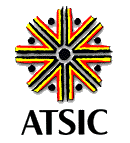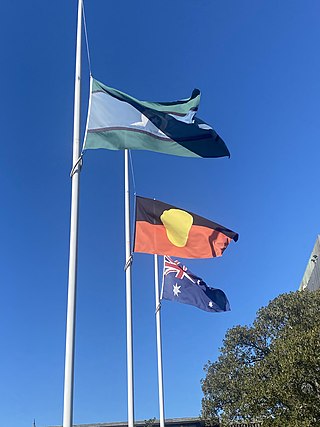Related Research Articles

The Aboriginal and Torres Strait Islander Commission (ATSIC) (1990–2005) was the Australian Government body through which Aboriginal Australians and Torres Strait Islanders were formally involved in the processes of government affecting their lives, established under the Hawke government in 1990. A number of Indigenous programs and organisations fell under the overall umbrella of ATSIC.
Reconciliation Australia is a non-government, not-for-profit foundation established in January 2001 to promote a continuing national focus for reconciliation between Indigenous and non-Indigenous Australians. It was established by the Council for Aboriginal Reconciliation, which was established to create a framework for furthering a government policy of reconciliation in Australia.

Marcia Lynne Langton is an Aboriginal Australian writer and academic. As of 2022 she is the Redmond Barry Distinguished Professor at the Melbourne School of Population and Global Health, University of Melbourne. Langton is known for her activism in the Indigenous rights arena.
Indigenous Australian self-determination, also known as Aboriginal Australian self-determination, is the power relating to self-governance by Aboriginal and Torres Strait Islander peoples in Australia. It is the right of Aboriginal and Torres Strait Islander peoples to determine their own political status and pursue their own economic, social and cultural interests. Self-determination asserts that Aboriginal and Torres Strait Islander peoples should direct and implement Aboriginal and Torres Strait Islander policy formulation and provision of services. Self-determination encompasses both Aboriginal land rights and self-governance, and may also be supported by a treaty between a government and an Indigenous group in Australia.

The Redfern Park Speech, also known as the Redfern speech or Redfern address, was made on 10 December 1992 by the then Australian Prime Minister, Paul Keating, at Redfern Park, which is in Redfern, New South Wales, an inner city suburb of Sydney. The speech dealt with the challenges faced by Indigenous Australians, both Aboriginal Australian and Torres Strait Islander peoples. It is still remembered as one of the most powerful speeches in Australian history, both for its rhetorical eloquence and for its ground-breaking admission of the negative impact of white settlement in Australia on its Indigenous peoples, culture and society, in the first acknowledgement by the Australian Government of the dispossession of its First Peoples. It has been described as "a defining moment in the nation's reconciliation with its Aboriginal and Torres Strait Islander people".
Indigenous Australians are people with familial heritage from, or membership in the ethnic groups that lived in areas within the Australian continent before British colonisation, or both. They consist of two distinct groups: the Aboriginal peoples of the Australian mainland and Tasmania, and the Torres Strait Islander peoples from the seas between Queensland and Papua New Guinea. The term Aboriginal and Torres Strait Islander peoples or the person's specific cultural group, is often preferred, though the terms First Nations of Australia, First Peoples of Australia and First Australians are also increasingly common; 812,728 people self-identified as being of Aboriginal and/or Torres Strait Islander origin in the 2021 Australian Census, representing 3.2% of the total population of Australia. Of these Indigenous Australians, 91.4% identified as Aboriginal; 4.2% identified as Torres Strait Islander; while 4.4% identified with both groups. Since 1995, the Australian Aboriginal flag and the Torres Strait Islander flag have been official flags of Australia.

The National Congress of Australia's First Peoples was the national representative body for Aboriginal and Torres Strait Islander Australians from 2009 to 2019.
Indigenous Australians are both convicted of crimes and imprisoned at a disproportionately higher rate in Australia, as well as being over-represented as victims of crime. As of September 2019, Aboriginal and Torres Strait Islander prisoners represented 28% of the total adult prisoner population, while accounting for 2% of the general adult population. Various explanations have been given for this over-representation, both historical and more recent. Federal and state governments and Indigenous groups have responded with various analyses, programs and measures.

Indigenous health in Australia examines health and wellbeing indicators of Indigenous Australians compared with the rest of the population. Statistics indicate that Aboriginal Australians and Torres Strait Islanders are much less healthy than other Australians. Various government strategies have been put into place to try to remediate the problem; there has been some improvement in several areas, but statistics between Indigenous Australians and the rest of the Australian population still show unacceptable levels of difference.

Thomas Edwin Calma,, is an Aboriginal Australian human rights and social justice campaigner, and 2023 senior Australian of the Year. He is the sixth chancellor of the University of Canberra, a post held since January 2014, after two years as deputy chancellor. Calma is the second Aboriginal or Torres Strait Islander person to hold the position of chancellor of any Australian university.

Mick Gooda is an Aboriginal Australian public servant. He has particularly served as the Aboriginal and Torres Strait Islander Social Justice Commissioner of the Australian Human Rights Commission from 2009 to 2016 and as Co-Commissioner of the Royal Commission into the Protection and Detention of Children in the Northern Territory from 2016 to 2017. He is a descendant of the Gangulu people of Central Queensland.
The Closing the Gap framework is a strategy by the Commonwealth and state and territory governments of Australia that aims to reduce disparity between Aboriginal and Torres Strait Islander peoples and non-Indigenous Australians on key health, education and economic opportunity targets. The strategy was launched in 2008 in response to the Close the Gap social justice movement, and revised in 2020 with additional targets and a refreshed strategy.
Pat Turner is an Aboriginal Australian of Gudanji-Arrernte heritage who has worked as a civil administrator for policies which guarantee the right to self-determination for Indigenous people. She was awarded the Order of Australia in 1990 for her service.
Kirstie Parker is a Yuwallarai journalist, policy administrator and Aboriginal Australian activist. From 2013 to 2015 she served as the co-chair of the National Congress of Australia's First Peoples and during her tenure pressed for policies that allowed Aboriginal and Torres Strait Islander Australians to gain the ability for self-determination.

The Aboriginal and Torres Strait Islander Voice, also known as the Indigenous Voice to Parliament, the First Nations Voice or simply the Voice, was a proposed Australian federal advisory body to comprise Aboriginal and Torres Strait Islander people, to represent the views of Indigenous communities.
Australians for Native Title and Reconciliation (ANTaR) is an independent, national non-government, not-for-profit, community-based organisation founded in 1997 which advocates for the rights of Aboriginal and Torres Strait Islander people in Australia and aims to help overcome disadvantage. Its staff, board and membership comprise mainly non-Indigenous people who support Indigenous voices and interests.

Reconciliation in Australia is a process which officially began in 1991, focused on the improvement of relations between the Aboriginal and Torres Strait Islander peoples of Australia and the rest of the population. The Council for Aboriginal Reconciliation (CAR), created by the government for a term of ten years, laid the foundations for the process, and created the peak body for implementation of reconciliation as a government policy, Reconciliation Australia, in 2001.
Constitutional recognition of Indigenous Australians refers to various proposals for changes to the Australian Constitution to recognise Indigenous Australians in the document. Various proposals have been suggested to symbolically recognise the special place Indigenous Australians have as the first peoples of Australia, along with substantial changes, such as prohibitions on racial discrimination, the protection of languages and the addition of new institutions. In 2017, the Uluru Statement from the Heart was released by Indigenous leaders, which called for the establishment of an Indigenous Voice to Parliament as their preferred form of recognition. When submitted to a national referendum in 2023 by the Albanese government, the proposal was heavily defeated.
Patricia Lynette Dudgeon, usually known as Pat Dudgeon, is an Aboriginal Australian psychologist, Fellow of the Australian Psychological Society and a research professor at the University of Western Australia's (UWA) School of Indigenous Studies. Her area of research includes Indigenous social and emotional wellbeing and suicide prevention. She is actively involved with the Aboriginal community, having an ongoing commitment to social justice for Indigenous people. Dudgeon has participated in numerous state and national committees, councils, task groups and community service activities in both a voluntary and professional capacity.
Vanessa Lee-AhMat is an Australian scholar who was the first Aboriginal and Torres Strait Islander PhD graduate from Griffith University School of Medicine. In 2005, Lee-AhMat was recognised by the Parliament of Australia for her dedication and commitment to Thursday Island community, in the Torres Strait.
References
- ↑ Calma, Tom (22 November 2005). "Social Justice Report 2005: Home". Australian Human Rights Commission. Retrieved 3 August 2020. PDF
- ↑ Cleary, Paul; Ring, Ian; Garay, Alex (24 June 2015). "Back Indigenous medical services to close the gap". The Guardian. Retrieved 3 August 2020.
- 1 2 3 4 5 6 7 8 9 10 "Close the Gap: Indigenous Health Campaign". Australian Human Rights Commission. 18 March 2020. Retrieved 3 August 2020.
 Text was copied from this source, which is available under a Attribution 4.0 International (CC BY 4.0) licence. (Details here.)
Text was copied from this source, which is available under a Attribution 4.0 International (CC BY 4.0) licence. (Details here.) - ↑ "Close The Gap Campaign". World Vision Australia. 28 July 2020. Retrieved 3 August 2020.
- ↑ "Govt promises action after apology". ABC News. ABC. 13 February 2008. Retrieved 3 August 2020.
- ↑ Calma, Tom (24 September 2008). "UN Declaration on the Rights of Indigenous Peoples: Australia should sign". Koori Mail. No. 435. Lismore, NSW: Budsoar. p. 27.
- ↑ "Close the Gap: Indigenous Health Equality Summit - Statement of Intent". Australian Human Rights Commission. 20 March 2008. Retrieved 3 August 2020. PDF
- ↑ Close the Gap Campaign Steering Committee for Indigenous Health Equality (2013). Shadow Report 2013 (PDF).
- ↑ "Close the Gap - Progress and priorities report 2014". Australian Human Rights Commission. 12 February 2014. Retrieved 3 August 2020.
- ↑ "Close the Gap - Progress & Priorities report 2017". Australian Human Rights Commission. 16 March 2017. Retrieved 3 August 2020.
- ↑ "Menzies School of Health Research on The Conversation". The Conversation. 31 July 2020. Retrieved 3 August 2020.
- ↑ "Australia marks 20-year anniversary of Sorry Day". SBS News. 26 May 2018. Retrieved 26 December 2019.
- ↑ "Closing the Gap". Australian Indigenous Health Infonet. Retrieved 10 January 2020.
- ↑ "Closing The Gap". Closing the Gap. Retrieved 3 August 2020.